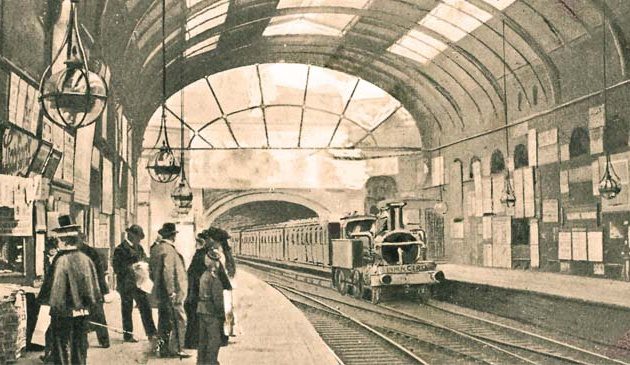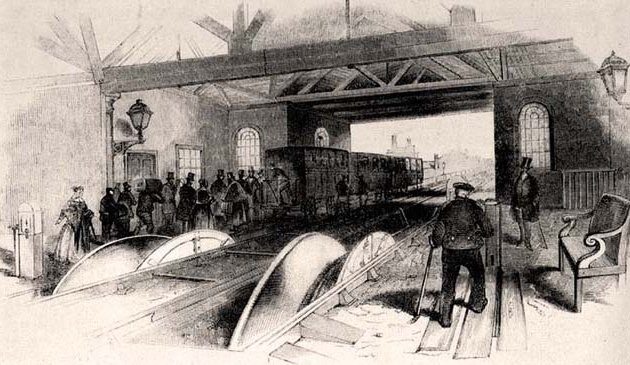London’s earliest long-distance railway

The entrance to the engine shed of the London & Birmingham Railway at Camden in 1838. This coloured lithograph was one of 50 made by the London artist John Cooke Bourne. He is best known for his pictures of the construction of the London & Birmingham and Great Western Railways, which were published in four volumes in 1838 and 1839. His interest in the railways was sparked when construction of the L&BR was taking place near his home.
The development of the steam locomotive in the 1830s led to a period of ‘railway mania’ in Britain. Privately financed railways soon linked every town in the country. People could rapidly travel from one place to a distant other. No longer was it necessary to journey in slow and uncomfortable stagecoaches over poorly maintained roads. In 1838 the world’s first long-distance trunk railway linked London with Birmingham, Manchester, and Liverpool.
The Stockton & Darlington Railway opened in 1825 in the North-East of England to carry coal. The first passenger railway to link two major towns was the Liverpool & Manchester Railway, which opened in 1830. Three years later royal assent was given for the creation of the London & Greenwich Railway, the first line to bring commuters into the City. That same year an Act was passed for a railway that would link London to Birmingham and the North-West of England.
Unlike the Greenwich line, the one to Birmingham was planned from the beginning as a trunk route, without consideration for suburban traffic. Although London was Britain’s largest and most populous city it was nevertheless compact, as yet with few suburbs, and a train could reach countryside within just a few minutes. The preamble to the Act for the London & Birmingham Railway stated:
WHEREAS the making of Railway, with proper Works and Conveniences connected therewith, for the Carriage of Passengers, Goods, and Merchandize from London to Birmingham, will prove of great public Advantage, by opening an additional, cheap, certain, and expeditious Communication between the Metropolis, the Port of London, and the large manufacturing Town and Neighbourhood of Birmingham aforesaid, and will at the same Time facilitate the Means of Transit and Traffic for Passengers, Goods, and Merchandize between those Places and the adjacent Districts, and the several intermediate Towns and Places.
The first proposal to build a railway from London to Warwickshire was in 1820, even before the introduction of steam locomotives, and named the ‘Central Union Railroad’. It was planned to run from Paddington via Oxford to Stratford-upon-Avon, from where goods would be transported by canal to Birmingham. Nothing came of it.
The next plan came from the London & Birmingham Railroad Company who commissioned John Rennie Jnr. to survey a route, which was undertaken in 1824 and 1825. It began at the East and West India Docks, skirted the City and Westminster via Islington and Paddington, and at its northern end was to link with the proposed Birmingham & Liverpool Railway. The scheme was abandoned, perhaps due to its cost.
In 1830 there were two competing proposals: another with Rennie, and a second that “will commence in the open grounds at Islington, near London, and proceed by Hornsey, East Barnet, South Mimms, Hemel Hempstead (where it will be joined by a branch from the Edgware road)…” and continue via Coventry to Birmingham. With the prospect of competing Bills going before Parliament the two companies decided to merge. The joint venture appointed George Stephenson to review their respective plans and he favoured the Coventry option. The London & Birmingham Railway Company was formed, with Stephenson appointed as engineer, although he increasingly took a back-seat in proceedings, with his son Robert taking on the bulk of the work.
There was a great deal of opposition from interested parties such as stagecoach and canal companies, turnpike trusts, farmers, and influential owners of country estates through which the line would pass. The first attempted Bill was passed in the House of Commons but defeated by aristocratic landowners in the Lords. One of those who opposed it was Charles FitzRoy, Lord Southampton, who owned much of the land between Highgate, Camden and Euston.
Some changes to the planned route were then made to avoid the estates of opponents. At Birmingham the proposed line would link with the Grand Junction Railway from Liverpool, which Stephenson was also working on, both companies sharing a terminus at Curzon Street at Birmingham. Over five million pounds was raised in capital, mostly from Lancashire cotton manufacturers who saw the benefit of transporting their products to the London markets. Extremely large sums were then promised in compensation to many opponents and a second Bill was attempted.
The London terminus in the Parliamentary Bill of 1831 was to be just north of the present King’s Cross station, allowing transhipment of goods to the Regent’s Canal, which linked to the London docks. In the revised Bill the terminus was moved to Camden
…on the West Side of the High Road leading from London to Hampstead, at or near to the first Bridge Westward of the Lock on the Regent’s Canal at Camden Town in the Parish of Saint Pancras in the County of Middlesex.
There was by then much support in the country for the creation of the railway and royal assent was received in May 1833.


